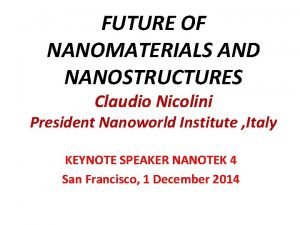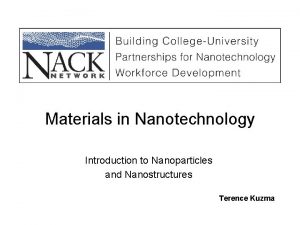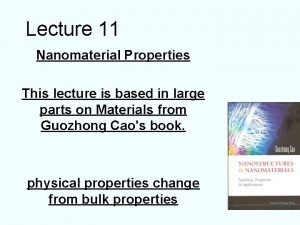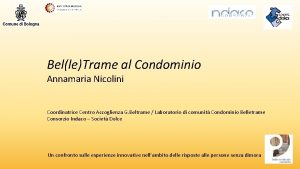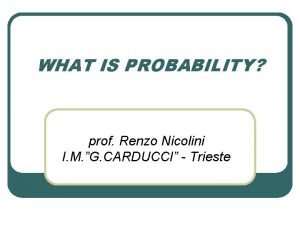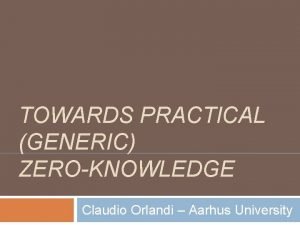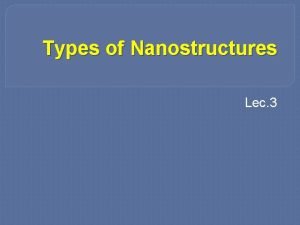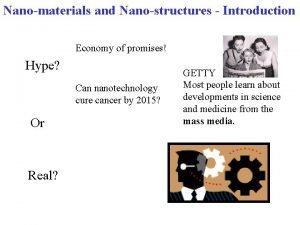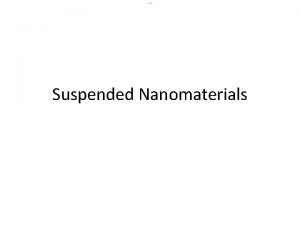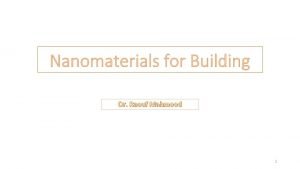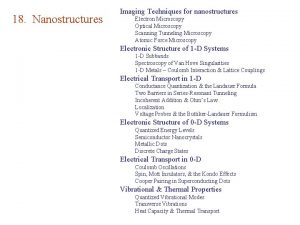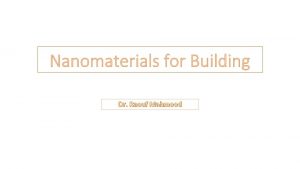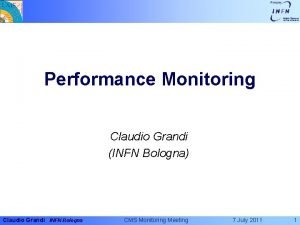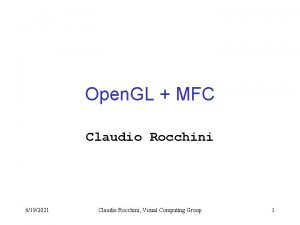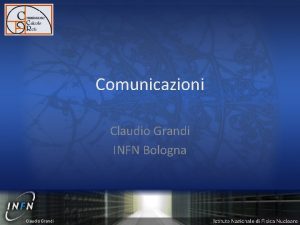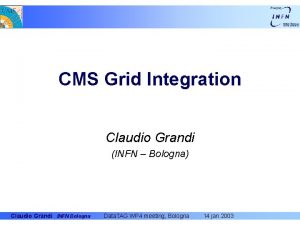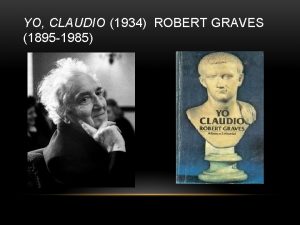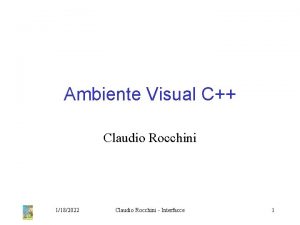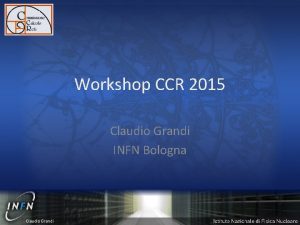FUTURE OF NANOMATERIALS AND NANOSTRUCTURES Claudio Nicolini President





















- Slides: 21

FUTURE OF NANOMATERIALS AND NANOSTRUCTURES Claudio Nicolini President Nanoworld Institute , Italy KEYNOTE SPEAKER NANOTEK 4 San Francisco, 1 December 2014

Nanotechnology for energy devices • Energy-oriented components, as intended in this paper, are elements designed in a power supply context, designed for the generation or the storage of energy in electrical form. Nanotechnology can help in the synthesis of materials with particular characteristics to make them suitable for the use in the energy field, particularly for the photovoltaic power generation and for the construction of parts of batteries, both object of this review. The constant development of highly integrated electronic devices is leading circuits to very small dimensions. The power supply must provide enough energy for the proper functionality of these structures, so it should be based on materials with high energy efficiency to limit the weight and the volume of the device. For energy storage purposes, lithium-ion electrolytic cells for batteries are nowadays considered the best dealing with these characteristics. For what concerns energy conversion from renewable sources, solar systems based on nonstandard construction techniques, like CISG (Cadmium Indium Gallium (di)Selenide) cells or dye sensitized solar cells (also known as Gratzel Cells)

Chemical intercalation of the lithium ions in the polymer. New nanomaterials for light weight lithium batteries,

Ciclability of nanomaterials for lithium ion batteries. New nanomaterials for light weight lithium batteries,

Current Variation as function of incident ligt on nanoassembled material obtained alternaring poli(o-metoxianiline monolayer to C 60. fullerenes In presence of 100 W lamp.

Mass Spectrometry and Protein Array for Biodisel production • mass spectrometry results evidenced the enzyme action of separating plastic oligomers of Poly (εCaprolactone) and of hydrolysing further the oligomers previously detached. . The degradation of PCL occurred by three fungal lipases from Mucor miehei, Candida rugosa and Rhizhopus arrizhus in a solvent- free system utilizing olive oil as substrate. Mucor miehei lipase proved to be the best biocatalyst matching catalytic activity for biodiesl production being strongly enhanced when the enzyme is immobilized on a glass surface in up to five monolayers.

MALDI-TOF mass spectrum of the degradation of a sample of PCL (A) after 1 day, (B) after 3 days (C) after 5 days.

Left) Comparison of lipase from Mucor Miehei activity dissolved in Milli Q water (solution) and immobilized in LB film when the reaction take place in Erlenmeyer flask. Right) PCL degraded by lipase from Mucor Miehei: (a) days 0, (b) I day, (c) day II, (d) III day, (e) IV day, (f) V day (g) day VI, (h) VII day.

Conductive Polymers for CO 2 Sensors on Poly(omethylaniline and nanocomposite with Nano. Ts conducting polymer were synthesized by oxidative polymerization. Langmuir-Schaefer (LS) films were fabricated at the air-water interface. Experimental data showed that the synthesized materials were able to detect carbon dioxide (CO 2) via nanogravimetric method. Aim of this work is to investigate the behavior of POTO and related nanocomposites in presence of CO 2. For this reason, nanogravimetric measurements were performed in a dedicated chamber filled with dioxide flux. Single acquisitions were performed and tests carried out demonstrate that these materials are suitable for applications as sensors for dioxide.

Scheme of the synthesis leading to the formation of a repeat unit starting from monomers. Basing on the fraction of imine nitrogen groups per repeat unit it is possible to obtain different reduced/oxidized polymer chains as following: Fully reduced form (leucoemeraldine base) for y = 1; Fully oxidized form (pernigraniline base) for y = 0; Half oxidized form (emeraldine base) for y = 0. 5.

Figure 1. Illustration of the plastic cells (see inset) containing the quartz for environmental CO 2 long-term sampling.

Figure 6 Variation of frequency in relation to the quantity of CO 2 absorbed by the composite. Experimental data showed a linear absorption, coherently with the human activity of the sampling. (left) Quartz frequency variation recorded with Single Walled Nano Tube (SWNT) of O-Methylaniline superposed on the quartz. .

The Role of π-π Interactions in the Charged Species Stabilizations of Conjugated Polymers for Nanoelectronics • interchain interactions of π-conjugated polymers, poly(2, 6 pyridinylenevinylene)-co-[(2, 5 -dioctyloxy-p-phenylene)vinylene] or PPy. PV, are investigated by UV-Vis absorption spectroscopy. The PPy. PV is a Lewis base and can be doped by strong and weak Lewis acids. The interchain interactions seems to play a fundamental role only in charged states. The basicity strength of the PPy. PV depends on the polymer interchain interactions, as the polymer concentration is increased, a Kb increment is observed, reversal a decrease of polymer concentration lowers the Kb of the PPy. PV. The organization of the polymer chains plays a fundamental role in the doping process. With the aim of developing enhanced chemical sensors, the influence of different multi-walled carbon nanotubes (MWNTs) on the physical and chemical properties of poly-o-ethoxyaniline (POEA) nanostructured films was investigated. It was found that the presence of MWNTs in POEA enhances the interaction between the aromatic structure of the poly(o-ethoxyaniline) and the basal plane of the MWNT graphitic surface via π-stacking, affecting the vibrational modes of the polymer, along with an improvement in thermal stability and surface morphology.

Representation of the conducting polymer chains wrapped around bundles of carbon nanotubes (Figure 10 From Nicolini et al, 2005).

Semi-quantitative mechanism of the interaction process and ropes formation of SWNTs by a conjugate polymer (PPy. PV), taking into account all the species in solution is proposed. Particular attention is paid to study the interactions as a function of nanotube and polymer concentrations ( from Stoddard, Heath Nicolini groups, , 2006

shows the spectra for the polymer in a chloroform solution at different concentrations. The increase in the absorption at 510 nm corresponds to the protonated form, which follows the increase in polymer concentration. It is interesting to observe the insert in Figure 4, which shows the formation of the doping peak after the addition of HCl to the polymer solution. Before the formation of the peak, the absorption at 510 nm showed a slight shoulder, which has the same shape that was seen by increasing the concentration. To prove that this shoulder/peak comes from the acid-base process we simply added a few drops of an aqueous ammonia solution to the concentrated polymer chloroform solution, and immediately the color turned form red to light yellow.

The reversible doping process is shown in the UV-Vis absorption spectra of a concentrated PPy. PV-chloroform solution (blue line) and the same solution after treatment with aqueous ammonia (red line). It possible to see that after the base treatment the shoulder disappears.

QCM_D Biosensor for Environment • innovative conductimetric biosensor has been implemented coupling Quartz Crystal Microbalance with Dissipation Monitoring nanogravimetry and an innovative protein cell-free expression system named Nucleic Acid Programmable Protein Arrays (NAPPA) that allow us to immobilize on the QC surface, as sensing molecule, any kind of proteins. The NAPPA spots have been imprinted utilizing both traditional technology and a new technology, called Nano. Probe. Arrays, based on piezoelectric liquid dispensing for non-contact printing and probing, that allows the realization of protein arrays for protein analysis with as little as a few nanoliters of sample. Here we present the results so far obtained employing our biosensor to monitor protein-protein and enzyme drug interactions and its future application to environmental analysis. Our conductimetric biosensor - as exploiting its capability to monitor reaction in real-time – proposes as an answer to the demands of fast-and costeffective analytical techniques to monitor the increasing number of potentially harmful pollutants in the environment

Figure 2. 4. Piezoelectric liquid dispensing for printing and probing of Nano. Probe. Arrays.

Fig. 2: Conductance curves of MM_p 53 QC. The curves were collected in different steps of NAPPA protocol, as reported in the legend, and after MDM 2 addition.

Fig. 3. Flow interaction between p 53 and MDM 2 in solution.
 Claudio nicolini
Claudio nicolini Simple cubic unit cell
Simple cubic unit cell Hardness of nanomaterials
Hardness of nanomaterials Magnetic properties of nanomaterials
Magnetic properties of nanomaterials Annamaria nicolini
Annamaria nicolini Renzo nicolini trieste
Renzo nicolini trieste Ducks unlimited president
Ducks unlimited president Future continuous and future perfect
Future continuous and future perfect Future perfect simple vs future perfect continuous
Future perfect simple vs future perfect continuous Future continuous.
Future continuous. Past continuous diagram
Past continuous diagram Future plans and finished future actions
Future plans and finished future actions Future perfect x
Future perfect x Kondicional engleski
Kondicional engleski Future perfect presentation
Future perfect presentation Present past future simple continuous perfect
Present past future simple continuous perfect Future nurse future midwife
Future nurse future midwife Future continuous tense
Future continuous tense How to use present continuous for future
How to use present continuous for future Claudio duran
Claudio duran Garbled
Garbled Bishop claudio gatti
Bishop claudio gatti
